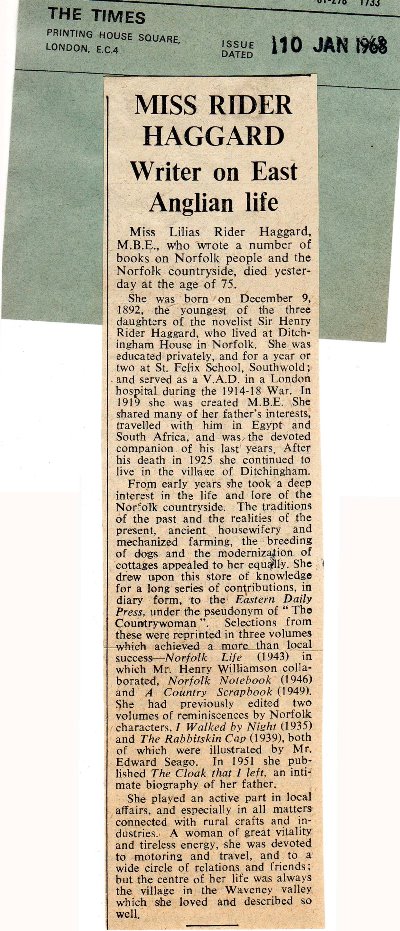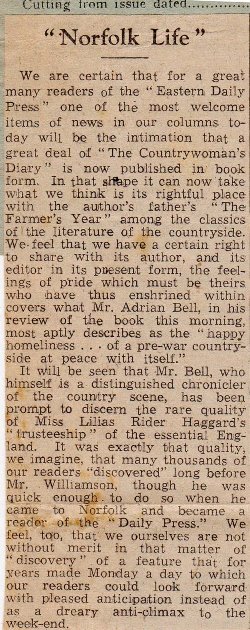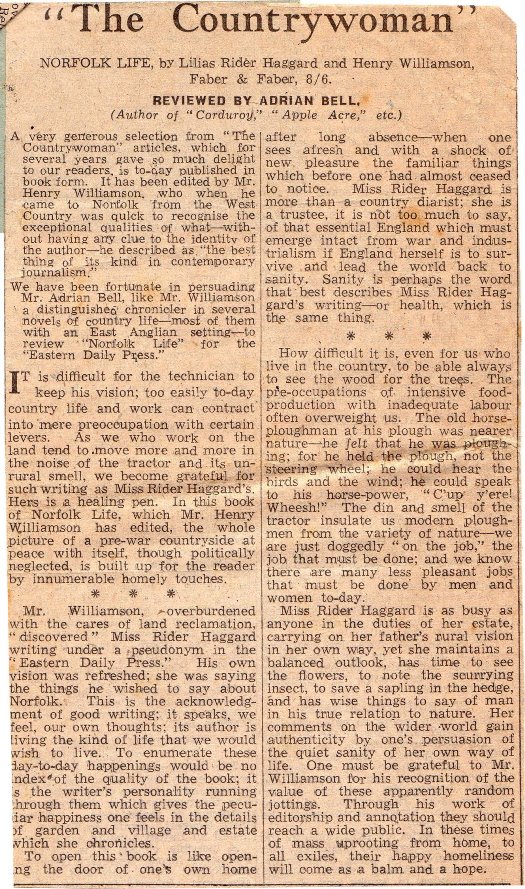NORFOLK LIFE
Lilias Rider Haggard and Henry Williamson
 |
|
| First edition, Faber, 1943 |
First published Faber and Faber, 1943, 8s 6d
Second impression, September 1943; 3rd, November 1943; 4th, April 1944; 5th, July 1944; 6th, March 1945; 7th, September 1945; 8th, March 1946; 9th, May 1948 (all at 8s 6d)
Alan Sutton Publishing, 1983
The first edition bears the disclaimer that was obligatory in all war-time books; it is omitted in the 8th and 9th impressions:

By the 9th impression the paper is of better quality, and the book accordingly slightly thicker. The front cover remained the same but the back and blurbs were changed.
**********
Dedication:

(This is Margaret Spurrell, devoted companion to Miss Haggard.)
An acknowledgement to the original source of the articles was also included:

*************************
The content of the book is a charming record of domestic and country life of the time, with a myriad of detail, drawn from Lilias Rider Haggard’s long series of pseudonymous contributions to the Eastern Daily Press. These appeared as if a diary, written under the name ‘The Countrywoman’.
The blurb to the first edition gives the gist of the background of HW's involvement in the book. Apart from that, there is no mention of it within HW's personal diary or papers. It is somewhat ironic that Miss Haggard herself 'had not the time' to undertake the editing work necessary, for HW was at that same time completely overwhelmed by everything that needed to be done on the farm. (The year before, HW had also written an Introduction to Sir John Russell's English Farming, published in 1942 in Collins's 'Britain in Pictures' series, highly collectable today.)
Chapter 1 (pp. 7‒12) acts as an 'Introduction' by HW, and the various footnotes throughout are also attributable to him. To discover exactly how much further work of an editorial nature was undertaken by HW would need careful examination of the original articles, and the absence of any attached dates makes the task difficult. It would seem, however, to have been quite considerable. (HW would not have been able to resist changing things!) It is known that Miss Haggard's friends objected ‒ almost violently ‒ to his 'interference' with her work, and when HW proposed a second volume they urged her to refuse, which she did. (In due course further volumes were published – but without HW's 'help'.) One reason for their objection may have been due to the fact that the earlier editions advertised HW's books only, which rather gave the impression that the work was more his than hers. Neither did it do HW justice that Faber marketed the book as if they were joint authors: as one reviewer pointed out, the book should more accurately have been entitled 'Norfolk Life, by Lilias Rider Haggard, edited with an Introduction by Henry Williamson'. Also, these friends were very 'County', with North Norfolk connections, and likely considered him an interloper. (Miss Haggard and Miss Spurrell both had property on the North Norfolk coast – no doubt they knew Muriel North, portrayed as ‘Lady Penelope’ in the Norfolk books of A Chronicle of Ancient Sunlight.)
HW did not take kindly to this criticism, feeling, quite rightly, that the book would not have been published without his involvement. Indeed, Miss Haggard's own letters (now in Exeter University as part of the HW archive) show that she was very appreciative of his help at the time.
Interestingly, in April 1943 HW himself started writing regularly in the Eastern Daily Press (known locally as the EDP), at first under the pseudonym of 'Jacob Tonson' and later, under his own name, the regular column 'Green Fields and Pavements' (these EDP articles were collected and published to celebrate the centenary of HW’s birth as Green Fields and Pavements, ed. John Gregory, HWS, 1995; e-book 2013). The articles are essential reading for a full understanding of HW's Norfolk Farm era. Perhaps Miss Haggard and friends resented this perceived usurpation, and that was the root ‒ or at least a part of ‒ their disquiet.
*************************
Lilias Margitson Rider Haggard, born on 9 December 1892, was the youngest of three daughters of Sir Henry Rider Haggard (1856‒1925), the famous author of King Solomon's Mines (1885), She (1887) and other adventure stories, many of which were set in Africa. He was also known as an 'agricultural reformer and Servant of the Empire', and knighted for his services. His A Farmer's Year (Longmans, 1899), being his 'Commonplace book for 1898', was well read by HW, with passages marked by him as having a particular relevance for his Norfolk Farm venture.
Lilias was born and died (but with much travel in between) at Ditchingham House on the Norfolk side of the River Waveney near Bungay, Suffolk, which along with the substantial Bath House and farms and cottages was on the estate of the family home of her mother, Louisa Margitson, which her parents took over on their marriage. Sir Henry himself, being the sixth son (and eighth child) of William and Ella Haggard of Bradenham Hall, Norfolk, had few 'family' prospects, and had to make his way in the world.
She served as a VAD (Voluntary Aid Detachment) nurse in the First World War (for which she was made an MBE in 1919). Lilias often accompanied her father on his foreign travels, and lived with him in his last years. She is perhaps best known for editing two books immortalising the lives of two Bungay country characters: I Walked by Night (1939), written by George Baldry (whom I knew when roaming banks of the Waveney as a girl), and The Rabbit Skin Cap: The Life and History of the King of the Norfolk Poachers, by Fred Rolfe (1935), tales told her by the men themselves which she wrote down more or less verbatim. Both books were illustrated by Edward Seago. She also wrote a biography of her father, The Cloak that I Left (Hodder & Stoughton, 1951).
There were two further volumes in the Norfolk Life style: A Norfolk Notebook and A Country Scrapbook. At the time of her death Lilias Rider Haggard had just completed the story of her mother's family, the Margitsons, Too Late for Tears, posthumously published privately by Waveney Publications.
Lilias, as might be expected, was a lady of strong personality and forthright opinions, especially in her later years. She was a friend of HW's first wife, Loetitia ('Gipsy'), who lived in Bungay after their divorce and the sale of Bank House, Botesdale (near Diss, Norfolk), where the Williamson family lived after leaving the Norfolk Farm. Indeed, for several years Loetitia rented from her the charming 'Wood House' (literally made of wood), a bungalow at the top of Bath Hills, where once had been a vineyard – now a steep wooded slope.
A biography was recently published: Lilias Rider Haggard: Countrywoman, by Victoria Manthorpe (Poppyland, 2015, £12.95).
Her death on 9 January 1968 was noted by an obituary in The Times:

*************************
The book attracted considerable attention from reviewers, doubtless as it made an attractive respite from the gloom of Britain at war in 1943, and it sold very well, running to 9 impressions. Several reviews also covered (in particular) No Rain in these Clouds, by David Smith, as an interesting contrast.
Eastern Daily Press (Adrian Bell), 20 August 1943 (farmer and author, Bell was a friend of HW); the review was accompanied by an editorial note:


And for interest and context – the reverse of the cutting contained the following war news:

East Anglian Daily Times, 30 August 1943:

Sunday Times (A. A. Milne), 5 September 1943:

Country Life (Howard Spring), 7 September 1943:

The Times, 8 September 1943:

The Listener, 9 September 1943:

The Spectator (C. Henry Warren), 10 September 1943:

The Observer (Sir William Beach Thomas), 12 September 1943:

John O'London's Weekly (John York), 10 September 1943:

Punch (H.P.E.), 15 September 1943:

Manchester Guardian (G.T.), 24 September 1943:

Time & Tide (H. J. Massingham), 2 October 1943:

Books of the Month (A. C. Boyd), October 1943:

*************************
The first edition, Faber, 1943:


Alan Sutton Publishing, 1983:
 |
 |
*************************
